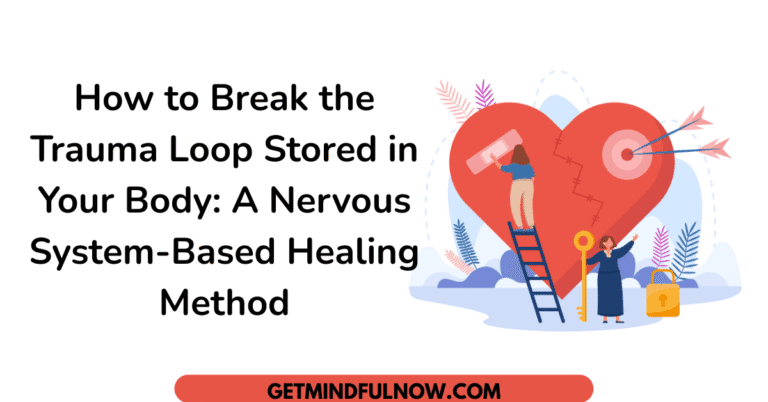Let me ask you something brutally honest.
Have you ever felt like no matter how much inner work you do, breathing techniques, yoga, therapy, journaling, the whole healing buffet, you still end up spiraling into the same emotional pit?
You promise yourself: “I won’t let it get to me this time.” And yet, there you are. Triggered. Flooded. Reacting like your past self hit “play” and took over the wheel.
This is what no one told you:
Your trauma doesn’t replay because you’re weak.
It replays because your body remembers it better than your brain does.
This isn’t just some philosophical idea. It’s a biological truth. And until you understand what’s happening at the cellular level, you’ll keep blaming your mindset for what’s actually a loop between your thoughts, emotions, and body chemistry.
Let’s go deep.
Your Body Is Your Trauma’s Favorite Recording Device
In Chapter 3 of Breaking the Habit of Being Yourself, Dr. Joe Dispenza drops a bomb:
“The body becomes the mind.”
What does that mean?
It means your body stores emotions like files, pain, fear, guilt, unworthiness, and automates your emotional reactions before your conscious mind can intervene.
Over time, if you keep feeling the same emotion over and over (let’s say anxiety), your body builds receptors for those chemicals. Your cells become more efficient at receiving anxiety signals. Like they’re addicted to it.
And if you try to think differently while your body still feels the same?
Your system panics. It yanks you right back into old emotions because they feel “safe.”
The body isn’t trying to sabotage you. It’s just trying to keep things familiar. Even if familiar means miserable.
The Thinking-Feeling Loop: A Real-Time Prison
This is where trauma feeds itself on autopilot. You’re not just reacting, you’re rehearsing the past in real time.
Let’s break it down precisely:
- You have a thought like: “I always mess this up.” That originates in the neocortex, the part of your brain that interprets experience and creates meaning.
- That thought sends a signal to the limbic brain, which translates the thought into an emotional chemical, let’s say shame or fear.
- Your body absorbs this chemical, and suddenly you feel the thought in your chest, your gut, your muscles.
- Now that you’re feeling insecure, your brain looks for more evidence to match the emotion, so it sends more insecure thoughts.
- These thoughts produce even more emotional chemicals.
- This creates a self-reinforcing biochemical feedback loop.
Your brain and body are now in agreement that this emotion is your reality. They don’t care if it’s a lie. They care that it’s familiar.
The longer this loop runs, the harder it is to break. Not because you’re not trying, but because your biology believes this loop is you.
Every time you repeat this pattern, you strengthen the neural circuits and chemical signals that keep it alive.
This is how trauma gets stuck, not just in memory, but in muscle tension, digestion issues, migraines, emotional flashbacks, and even your posture.
You don’t just remember the trauma.
You become it—over and over again—until your body literally doesn’t know how to live without it.
What Happens at the Cellular Level? (And Why It Keeps You Stuck)
Let’s zoom in, way in.
When you have a strong emotional reaction, like betrayal, panic, or heartbreak, your brain sends chemical messengers into the body. These include stress hormones (like cortisol and adrenaline) and a flood of neuropeptides, which are tiny information-carrying molecules that tell your body how to feel.
Each one of your cells has thousands of receptor sites on its surface, imagine them like keyholes. And those neuropeptides are the keys.
So when you feel anger, your brain sends out a neuropeptide “key” that fits into your cells’ “anger” keyholes. The more often you feel that anger, the more your cells start building more keyholes for that exact chemical. They become biologically hungry for it.
Over time, your cells begin to favor these familiar emotional chemicals. And here’s the catch: if you stop feeding them the usual emotions, say, you start practicing calm or joy, your body can go into a withdrawal-like response. It craves the drama. It searches for the fight.
Even peace can feel uncomfortable, because your biology hasn’t practiced it enough.
This is the cellular addiction to the past.
So when people say, “just choose a new thought,” it doesn’t land, because unless your body believes that thought, it won’t feel safe enough to let go of the old programming.
You’re not just healing your beliefs.
You’re reconditioning your cells.
And that takes repetition, presence, and emotional rehearsal that becomes more real than the body’s memory of pain.

Real Life Example: Addicted to Guilt
There was a time when I couldn’t go a single day without feeling guilty.
Even on good days. Even when no one was blaming me. I would search my thoughts for something I had done wrong, or not done well enough. I’d over-apologize in texts. I’d feel responsible for people’s moods. If someone was upset, I assumed it was my fault.
What I didn’t realize then was that guilt had become my baseline. It was the emotion my body was most familiar with. If I wasn’t feeling guilty, I felt off, like I was doing something wrong just by being okay.
And anytime I tried to shift into self-worth or joy, it felt fake. Like wearing clothes that didn’t fit.
I now understand that my body had memorized the chemical signature of guilt. It wasn’t just a thought, it was a feeling I was trained to seek because it made me feel “safe.” Predictable. Small, but safe.
Letting go of guilt wasn’t a mindset shift. It was a full-body retraining. And it started with recognizing: I had built my identity around guilt, and I was afraid of who I’d be without it.
The Lie of “Just Let It Go”
“Just let it go” sounds beautiful, on paper. In Instagram quotes. In spiritual bypass circles.
But here’s the hard truth:
You can’t just let go of trauma if your biology is still holding on.
Letting go isn’t a button you press. It’s a process of dislodging emotion from the body’s identity system.
Your body doesn’t “let go” because you decide it should. It lets go only when it no longer relies on those old emotions to define who you are.
That means:
- You can’t let go of anger if anger makes you feel powerful.
- You can’t let go of guilt if guilt gives you control.
- You can’t let go of fear if fear is how you feel safe.
“Letting go” actually starts with becoming conscious of why you’ve been holding on.
You have to sit with the addiction, not shame it.
You have to show your body something better, consistently, until it believes that safety, peace, and love are not temporary highs but home base.
And that doesn’t come from bypassing the pain. It comes from retraining every layer of your being to know:
“I no longer need this emotion to survive. I choose something new to live.”

7-Step Practice: How to Interrupt the Trauma Replay in Your Body
This is what I did when I was tired of the same emotional reruns:
1. Enter a Calm, Receptive State
Sit still. Breathe slow. Get into alpha or theta brainwaves. You need your body to soften and stop running on stress hormones.
2. Bring Up the Familiar Emotion (on Purpose)
Yes, call in that trigger. But do it consciously. See the moment. Hear the words. Feel the sensation. Don’t run from it. Witness it.
3. Interrupt the Thought Before It Hooks You
Now that it’s up, stop the thought spiral. Say internally: “That was my past. I’m safe now.”
This is your prefrontal cortex reclaiming power.
4. Release the Old Emotion Physically
Breathe it out. Shake. Cry. Move. Let the body release the loop. This is not mental. This is physical.
5. Install a New Emotional Signature
Ask: What do I want to feel instead?
Then feel it in your body. Use memory, visualization, or prayer. Let gratitude, joy, confidence land fully.
6. Mentally Rehearse a New Reaction
Picture the same trigger, but this time, you respond as your future self. Calm. Present. Powerful.
Your brain will start rewiring as if it already happened.
7. Repeat Until Your Body Gets It
You’re not just “doing inner work.” You’re retraining your cells. Repeat daily until your body wants to feel peace more than it wants to survive pain.
Journal Prompt: Where Does My Body Still Live in the Past?
Write down:
- The top 3 emotional reactions you want to change
- The specific situations or people that trigger them
- The physical sensations you feel when they happen
Then ask: What new emotional state do I want my body to practice instead?
Start there.
Final Truth: Your Body Isn’t Betraying You-It’s Waiting for You to Lead
You’re not stuck because you’re doing it wrong.
You’re stuck because no one taught you how to recondition the body. How to interrupt the loop. How to teach your cells a new identity.
But now you know.
So stop waiting to feel better before you act new.
Start feeling new until your body forgets the old you ever existed.
You’ve got this.
Want More Like This?
Subscribe to my newsletter and Threads for weekly deep dives on rewiring trauma, regulating your nervous system, and becoming the version of you that your body hasn’t caught up with—yet.
Because you’re not just changing your mindset. You’re changing your biology.
And I’m right here with you.








